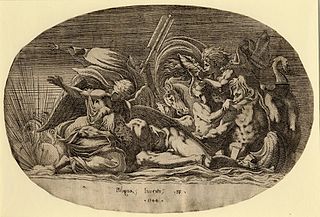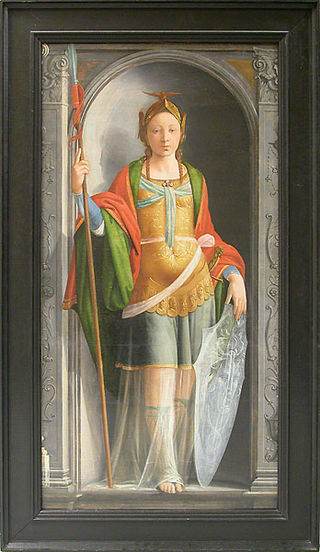
Palace of Fontainebleau, located 55 kilometers southeast of the center of Paris, in the commune of Fontainebleau, is one of the largest French royal châteaux. It served as a hunting lodge and summer residence for many of the French monarchs, beginning with Louis VII. Francis I, Henry II, Louis-Philippe, Napoleon Bonaparte and Napoleon III. Though the monarchs only resided there for a few months of the year, they gradually transformed it into a genuine palace, filled with art and decoration. It became a national museum in 1927 and was designated a UNESCO World Heritage Site in 1981 for its unique architecture and historical importance.

The French Renaissance was the cultural and artistic movement in France between the 15th and early 17th centuries. The period is associated with the pan-European Renaissance, a word first used by the French historian Jules Michelet to define the artistic and cultural "rebirth" of Europe.

Jean Goujon was a French Renaissance sculptor and architect.

Portrait of Baldassare Castiglione is a c. 1514–1515 oil painting attributed to the Italian High Renaissance painter Raphael. Considered one of the great portraits of the Renaissance, it has an enduring influence. It depicts Raphael's friend, the diplomat and humanist Baldassare Castiglione, who is considered a quintessential example of the High Renaissance gentleman.

The Diana of Versailles or Artemis, Goddess of the Hunt is a slightly over-lifesize marble statue of the Roman goddess Diana with a deer. It is currently located in the Musée du Louvre, Paris. The statue is also known as Diana with a Doe, Diana Huntress, and Diana of Ephesus. It is a partially restored Roman copy of a lost Greek bronze original attributed to Leochares, c. 325 BC.
Michel Laclotte was a French art historian and museum director, specialising in 14th and 15th century Italian and French painting.

Antoine Caron (1521–1599) was a French master glassmaker, illustrator, Northern Mannerist painter and a product of the School of Fontainebleau.

The Henry II style was the chief artistic movement of the sixteenth century in France, part of Northern Mannerism. It came immediately after the High Renaissance and was largely the product of Italian influences. Francis I and his daughter-in-law, Catherine de' Medici, had imported to France a number of Italian artists from Raphael's workshop or former assistants of Michelangelo, known as the School of Fontainebleau, where many were based. Frenchmen were trained in the Mannerist idiom. Besides the work of Italians in France, many Frenchman picked up Italianisms while studying art in Italy during the middle of the century. The Henry II style, though named after Henry II of France, in fact lasted from about 1530 until 1590 under five French monarchs, their queens, and their mistresses.

Northern Mannerism is the form of Mannerism found in the visual arts north of the Alps in the 16th and early 17th centuries. Styles largely derived from Italian Mannerism were found in the Netherlands and elsewhere from around the mid-century, especially Mannerist ornament in architecture; this article concentrates on those times and places where Northern Mannerism generated its most original and distinctive work.

Pietà of Villeneuve-lès-Avignon is an oil painting of the mid-15th century that is considered one of the outstanding works of art of the late Middle Ages. Following its appearance at an exhibition in 1904 its authorship was disputed, though it has since been accepted as the work of Enguerrand Quarton. It is now in the Musée du Louvre.

Antonio Fantuzzi was an Italian painter and printmaker active in the French Renaissance in a Mannerist style. All that is known about his early life is that he was born in Bologna, from the accounts at Fontainebleau and one inscription on a print.

The Fountain of Diana, also known as the Diana of Anet and Diana with a Stag, is a marble Mannerist sculpture of the goddess Diana, representing Diane de Poitiers. It was created c. 1550 to be the central ornament of a grand fountain in a courtyard of Diane de Poitier's Château d'Anet, but today is in the Louvre, Room 214 on the ground floor of the Richelieu Wing ; the Louvre has retitled it Diane appuyée sur un cerf. It was long believed to be the work of Jean Goujon, but the identity of the sculptor is now considered uncertain, although Benvenuto Cellini, Germain Pilon, Pierre Bontemps, and Ponce Jacquiot have in turn been suggested.

Diana Bathing or Diana Getting out of her Bath is an oil-on-canvas painting by French artist François Boucher, created in 1742. It depicts the Roman goddess Diana, with a nymph as her companion. The painting was acquired in 1852 by the Louvre, in Paris.

The Master of Flora was a French painter, associated with the School of Fontainebleau, who was active in the middle of the 16th century.
Principal Monuments of France is a series of four paintings created by the French artist Hubert Robert in 1786. They depict the ruins of several Roman structures in Provence.

The Nymph of Fontainebleau, also known as the Nymph of Anet or the Nymph with the Stag, is a c.‑1543 bronze relief, created by the Italian sculptor Benvenuto Cellini for the Château de Fontainebleau in France. It features a long-limbed reclining nude female nymph with a stag, wild boars, dogs, and other animals. It was Cellini's first large scale bronze casting.

Minerva is an oil-on-panel painting created c. 1490–1495 by the Italian Renaissance painter Fra Bartolomeo, now in the Louvre in Paris. It forms a pair with Porcia (Uffizi).

Bacchus, Venus and Cupid is a 1531–1532 oil-on-canvas painting attributed to the Italian Mannerist painter Rosso Fiorentino, now in the National Museum of History and Art in Luxembourg.

Diana and Endymion, also known in French as Diane et Endymion, is an 1822 oil-on-canvas painting by Jérôme-Martin Langlois. The painting depicts the Roman goddess Diana, one of the twelve Gods and Goddesses of Olympus, falling in love with Endymion and is painted in the Neoclassical style.
Philippe Millereau was a French Mannerist painter of the late 16th and early 17th centuries, active during the reign of Henri IV, and assimilated to the Second School of Fontainebleau, of which he remained a relatively minor figure; he was clearly influenced by Toussaint Dubreuil, but also by Italian artists such as Nicolò dell'Abbate, and Flemish painters. Art historians see him as a "petit maître" of this period.


















